Travelling with the King (19th century)
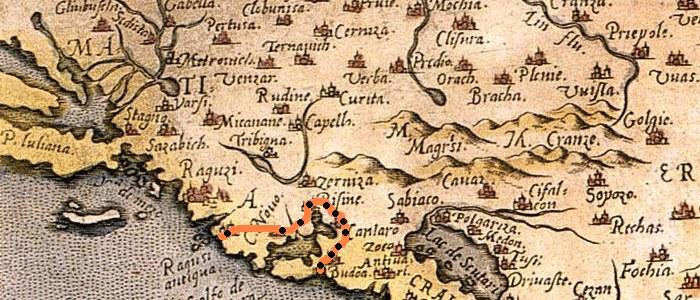
In May of 1838 the King of Saxony Frederick Augustus, passionate about botany set off on a voyage along the eastern Adriatic in search of wild flora and the little known Dalmatian coast. In Trieste he was joined by Bartolemo Biasoletto, an Italian botanist who kept a diary throughout the journey(The travels of Frederick Augustus of Saxony in Montenegro) who thanks to this we know what happened and in particular the meeting between the king and the young Vladika and prince –bishop, head of Montenegro, Pietro II Petrovic Njegos.
It is in fact this stepping off in Montenegro during this journey which we wish to propose as an itinerary; from the impervious coasts to the mountains towards the royal palace of Cettigne, headquarters of Vladika , who was one of the most important romantic Slav poets. This is a relatively short itinerary, and for those of you who have more time available you could continue towards the interior of Montenegro, and or Scutari (Skodra) going towards Albania or to reluctantly proceed on the Biasoletto, along the Istrian Dalmatian coasts.
|
|
At dawn on the 30th April the travellers boarded the steamboat “Conte Mittrowsky” of the Austrian Lloyds’in Trieste leaving behind Istria and Dalmazia and proceeded towards the Bocche di Cattaro.
|
First of all they saw before themselves a vision of Ragusa vecchia (Cravat Croazia) , the old Epidaurus surrounded by its walls, situated at the bottom of a bay and then in a very short time they found themselves in sight of the Cattaro Channel.
This is a torturous channel, very long, becoming narrow and widening at various points, and is similar to a large lake., in that it is enclosed by a chain of rocky mountains, in fact naked in their peaks, divided in sizes and the their depth.
|
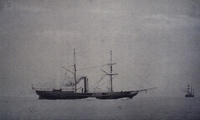
The Vessel "Conte Mittrowsky"
|
|
We suggest that you relive this experience at the same time as it was visited before, in the Spring. Also for those who will not be arriving by boat, it will be possible to hire a boat or take a ferry, in order to relive the emotions felt when you finally reach by sea the Bocche (Boka Kotorska).
One is able to choose to visit this enchanting place either from the sea to the bay or to follow the route along the coast line, identifying the Adriatic vegetation.
|
|
The coast line remains intact with its charming greenery, perfumed fruit trees and the partially opened views onto the tiny cities and hamlets, mirrored in the calm waters, and surrounded and protected by rocky mountains from all sides, preserving a perfect feeling of peace and quiet.
The first city is Castelnuovo (Herceg-Novi): Castelnovo (Castrum novum sive neocastrum), a city of more than 600 inhabitants, and headquarters of the same name, a place which is 200 feet above sea level. The city itself is small and surrounded by walls, with two forts, one called earth, the other called the sea, both having fallen victim to earthquakes, there are two ports, one the earth port or the big port and the other a sea port, two small hamlets,Topla and Savina. At a distance of about 400 feet one can find a fort said to be Spanish, built by the Spanish during their stay in the place in 1538.
|
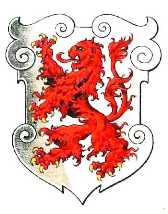
Coat of arms of Kotor
|
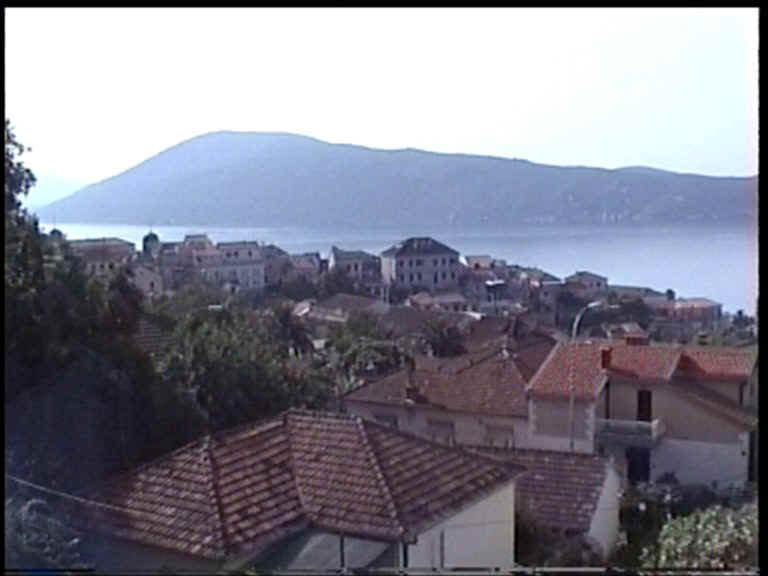
View of Herceg-Novi
|
The position of the city is pleasant, the surrounding vegetation is lush and one can head towards the locality of Magazza and then towards the convent of Savina which are both enchanting. The city of Castelnuovo today has more than 16,000 inhabitants and is called the city of flowers. Sailors from the area often bring in plants and flowers from their long travels, transforming their city into a large garden.. An impression particularly created by Mimosa, which is abundant in February in Castelnuovo.
|
|
Other than the fort and the “Bellavista” square, we would like to suggest a visit to the naval museum “Kapetum Stumberg”, and in the footsteps of the King of Saxony , the country church of San Saba,and the nearby monastery of Savina, a spiritual oasis situated 2km to the East of Castelnuovo.

Castelnuovo
A few steps away elevated on high at the quiet country church called San Saba, offers a rare beauty for those who wish to walk a road shaded by high oak trees, with their branches and boughs interwoven. “The Spartium junceum flowerin, the Madreselva (Lonicera caprifolium) perfuming with their fragrances of the early morning, continuing along the same way until we reach the Greek Convent called Savin.
|
After Castelnuovo, and going a little deeper one meets Perasto,(Perast), a charming town full o Venetian architecture, and today the headquarters of an association of young architects, busy re launching and preserving the art and beautiful landscapes of Montenegro for a sustainable tourism.
The old town of Perasto, is different from both Cattaro and Budva, as it is not surrounded by defensive wall. Instead, the defence of the town was left in the hands of small towers, nine in all, in which the most important was the tower of the prevailing saint. In the 19th century Perasto had reached its peak of prosperity, with four naval dockyards and a float of one hundred ships.
|
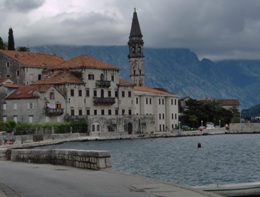
Perast
|
|
In front of Perasto, is San Giorgio, a romantic cliff covered in cypresses and is alongside the island called Madonna of the Scapello (a miraculous icon dedicated to the Madonna), almost the bridge of a ship with the bow projecting to Levante, it has a small church, rich in paintings and banners and of the ex holy orders in silver, with an annex of living quarters for the old but cultured priest who entertained and spoke to the king (all that remains today is a frowning keeper) while Frederick Augustus made a small pencil drawing from his small window of the surrounding landscape.
|
|
Madonna of the Scapello
|
We propose that even today that the journey you make should be made calmly so that pleasant memories can also be recorded and taken in. According to legend, this artificial island in the bay of Cattaro, was created by the returning sailors who all put a rock in the bay. The first church was built in the 15th century and the current one in 1632. In order to reach the coast situated in front of the island, for a small price it is not difficult to find a small boat to transport you there.
|
Two miles from Perasto, Risano (Risan, Rhizinuim)can be found and remembered by Plinio, as a channel which takes the name of Sinus Rhizonicus.
|
|
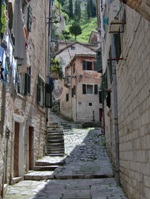 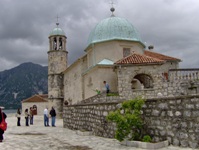 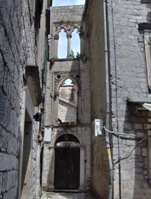 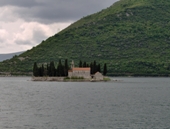
Lane of Kotor Madonna of the Scapello Lane of Kotor, particular S.Giorgio
|
|
|
|
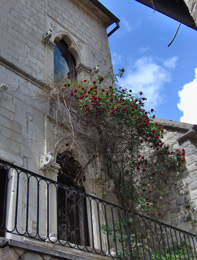
Kotor
|
Situated at the foot of Mount Lovcen, the small city of Cattaro is one of the most beautiful towns on the Adriatic coast. Protected by its walls stretching for 4.5 km and of a height of 20 metres, Cattaro is partly situated on the bank of a gulf of the same name and partly on the slope of a steep rock, it is easily recognised by its Venetian Architecture. It was once a famous artistic and cultural centre, Cattaro,is a blend of natural beauty of the gulf and ancient architecture, testimony to centuries gone by.
|
|
The main streets are particularly narrow, with spacious squares and well paved, the houses are all in all are built fairly small, possibly due to the frequent occurrences of earthquakes. It is also the seat of an archbishop and has an old and very fine cathedral, a collegiate, a monastery, various chapels, a hospital… It has three gates, one facing the sea, named Portamarina, the second Portafiumera, and is the one that faces the Bazzar de’ Montengrini, which is in fact in the town of Dobrato, the third gate Gordichio, which refers to the road of Budua.
|
|
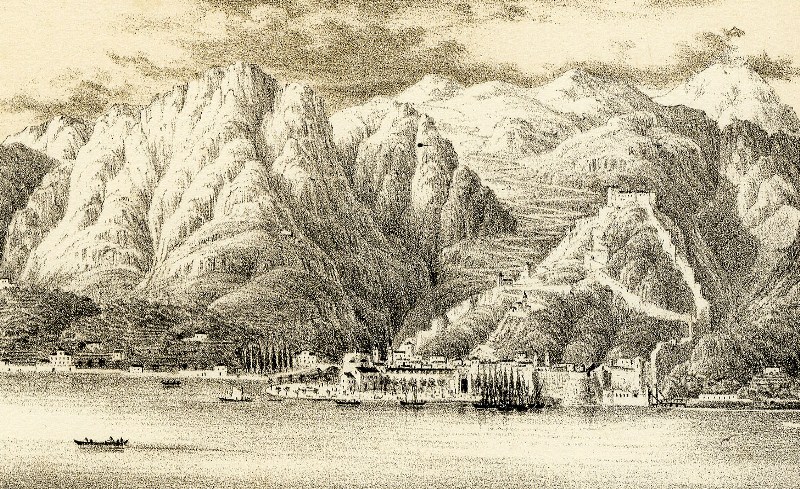
Kotor, street of Montenegro
|
|
The port is excellent, and is very commercially active, providing work to most of the population, like most coastal ports, with navigation and an extensive traffic, of boats of both great and small sizes.
|
|
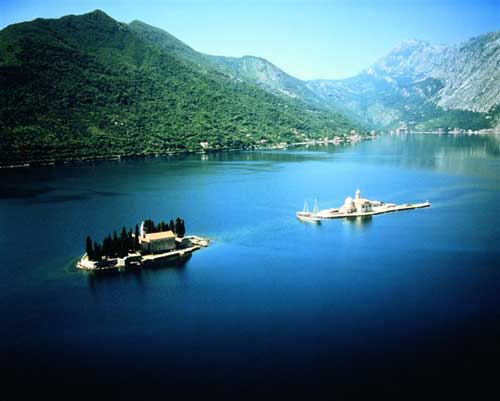
Bay of Kotor
|
|
Probably one of the most important monuments is without doubt that of the church of San Trifone, protector of the city, whose whitened towers are in direct contrast to the deep green background of the mountins, where our travellers ( like those before them) may observe the rare relics and beautiful sculptures preserved in this sacred place, enjoy the refreshments on offer (it is just as enjoyable sitting at one of the tables outside the many bars in the square).
|
|
Probably one of the most important monuments is without doubt that of the church of San Trifone, protector of the city, whose whitened towers are in direct contrast to the deep green background of the mountins, where our travellers ( like those before them) may observe the rare relics and beautiful sculptures preserved in this sacred place, enjoy the refreshments on offer ( it is just as enjoyable sitting at one of the tables outside the many bars in the square).
|

View of Kotor
|
At the top of the mount (about 400 feet), an enormous isolated cliff is revealed with precipitating abyss on the opposite side and at foot of this is this village of Spigliari (Spiljari), the sovereign was able to enjoy a beautiful sea view, before descending to visit the bazaar, a lively market frequented by the women, with a small running stream of pure water, which drives the wheels of two water wheels. Men, suntanned, dressed in national costume ,with long garments and embroidered jackets, with jewelled handled Turkish knives . the women also richly dressed danced traditional dances before the king, all this is recorded in minute detail in Biasoletto’s description (page 44), singing the rhythm tic songs of the area, lasting late into the evening, after which bonfires where lit along the shore and the canals.
|
|
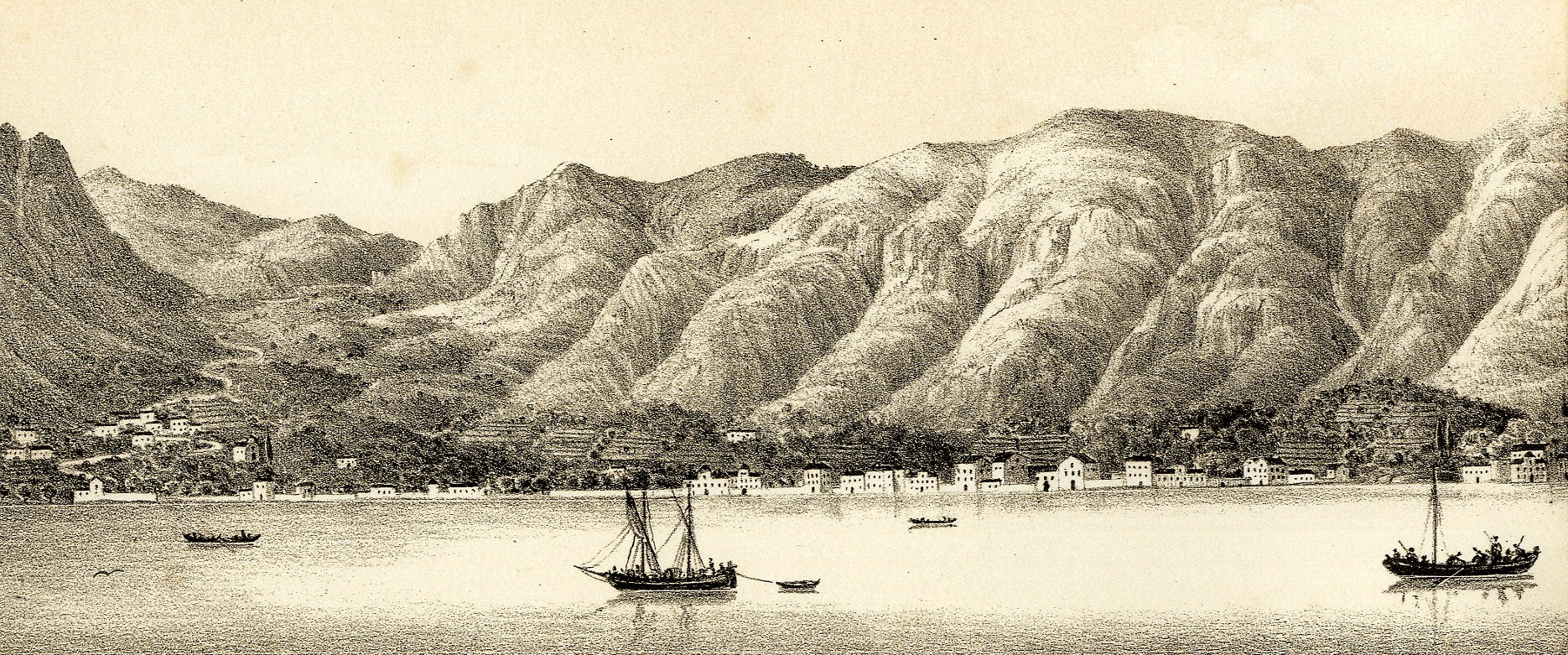
Cattaro, Forte S.Trinità
|
|
Invitations were received from Vladika Pietro II Petrovich Njegos, Montenegro’s greatest poet, the travellers decided to make the journey, and were escorted by about thirty heavily armed inhabitants of cattaro to his residence in Cettigne. The journey was an arduous one, along the alpine paths where one would meet only with rocks and ravines , characteristic of the place.
When suddenly they saw before their eyes a vast and beautiful horizon, which drove away any sad thoughts, a view of the city of Budua, mirrored in its waters with its beautifully cultivated hillocks, its pleasant countryside which extended towards Pastrovichio, along the foot of the mountain; in addition to the sight of parts of Scutari and also the sea borders of Albania, Turkey and Giannina etc...
|
|
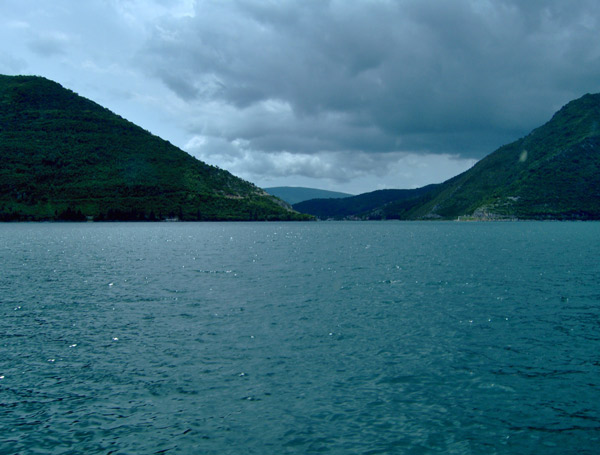
Boka Kotorska
|
|
Today it would be very easy, for those with an enough time to prolong the experience of following in the tracks of the King of Saxony, by extending the itinerary towards Albania, reaching the places which can only be seen from a distance, from the mountains of Montenegro.
After reaching the Vladika, the king and his travelling companions took a rest in the “seats carved out of the rocks”, refreshing themselves with oranges and the cold fresh water of a stream (close to our feet a stream ran by, from under the rocks and it was, desired by all to take a moment to relax in order to sustain ourselves with a few dried oranges and the naturally refreshing water.) after which the procession continued on its journey towards the Montenegro capital. The walk was an austere one, between gorges and ravines, with rare scrub and woods of beech trees:
Nevertheless , this was a horrible and frightening journey, but there were no end to privileges of witnessing a unique rarity and beauty , due to the natural beauty of the views, which wiped away the austerity, the balsamic odours, that serene sky, with an agreeable temperature which could be enjoyed even by the gods, the pleasure of reaching that far off horizon, elevated up into another world,…those gorges and with valleys, even though they precipitated and were wild, they were covered with their boring beeches, under which we found a mysterious but welcoming shelter , a pleasurable freshness… the grass was sustained by the soil…here and there, clods of brilliant earth, keeping roots of creeping couch grasses. The vegetation offered to us a comfortable resting place, in order to reflect, contemplate in our solitude, far away from noise and distractions, the great sublime of nature.
|
|
This place despite the distortions made by modern tourism, its beauty has refused to fade, and it remains a part of Montenegro which offers even now these sensations intact. To reach Cettigne, today it is possible to take a new road, or you can take another route which is even more dangerous, with little traffic but full of hairpin bends, reserved for the bravest and tenacious, but rewards one with a special prize.. Getting to the top of the mountain, you are open to an imposing view overlooking the Bocche of Cattaro, which is able to take the breath away from even the most experienced nature lover.
In green glades, still with the last snow flakes of Spring, dismounted from their horses the group, conceded a pleasurable rest , lying on the grass, looking around at the flowers and plants, and taking part in a kind of picnic on the grass, based on bread and a typical dish called “castrato” enjoyed by those living inland from the Adriatic coast, roasted in a nearby hut.
|
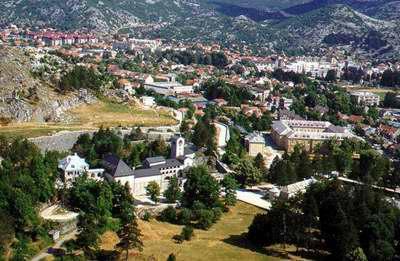
View of Cetinje
|
|
The same shepherd cook brought to us the freshest of cheeses made from the best of milk, clear water and local wine. Who can want for more drinking so refreshingly, with the snow close to us, serving us with such pleasures…
It was not until the evening, that during this mountainous path, there began to appear a few country houses, dotted about close to the spring, and it was the inhabitants of these, country people who were ready and waiting to receive and welcome this group of travellers.
After a journey of several hours, the bells of the bell tower announced that they were close by to the residence of the Prince Bishop. It was a convent, a simple but austere building , described in minute detail by Biasoletto, as an old and rustic building of the Senate, an archaic estate of shepherd kings. The future residence was under construction and today it is of the most visited places in Cettigne (Cetinje).
|
|
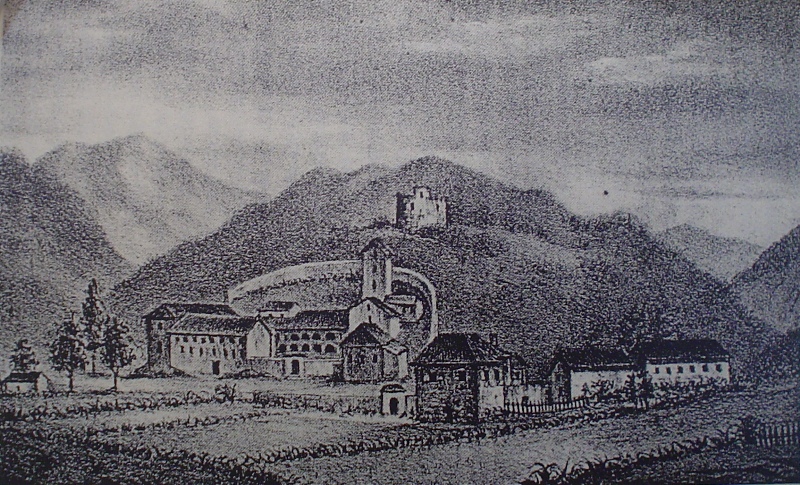
Cettigne
|
|
In fact its defensive position has for centuries protected it from its enemies., especially during the Turkish domination.
This symmetric valley, surrounded by gigantic walls, held together by their natural thickness, but at the same time giving pleasure only found in another world, protecting but at the same time an invincible fortress, situated in the middle of so many mountains, which seem to be fused one to another, enjoying pure air and from what I can see a temperature which is acceptable.
Cettigne represents the souls of all those who have long fought for the freedom and liberty of Montenegro. It is a city which has an high concentration of spirit and proud warriors. It is often called the museum city, it is special city renown for its streets and its unique architecture. One should not miss a visit to the Mausoleum, found at the top of Mount Lovcen where one can find the tomb of Vladika Pietro II Petrovich Njegos. Apart from its heroic past, Cettigne is also famous for its smoked ham and locally produced cheese, made according to the old cheese making traditions. Taking the scenic route , close to Njegos’ house, one can find the first private café opened in Montenegro where the atmosphere of 100 years ago still reigns. One can stop to drink a glass of gentian liquor with the owner, and one can be mistaken into believing that time has stood still. The national musical instrument of Montenegro is the gusle, and even today it can be found with its monotone and monochords, mirroring the simplicity and the melancholy of the inhabitants of Montenegro, who thought only of defending themselves and their love of simplicity.
|
|
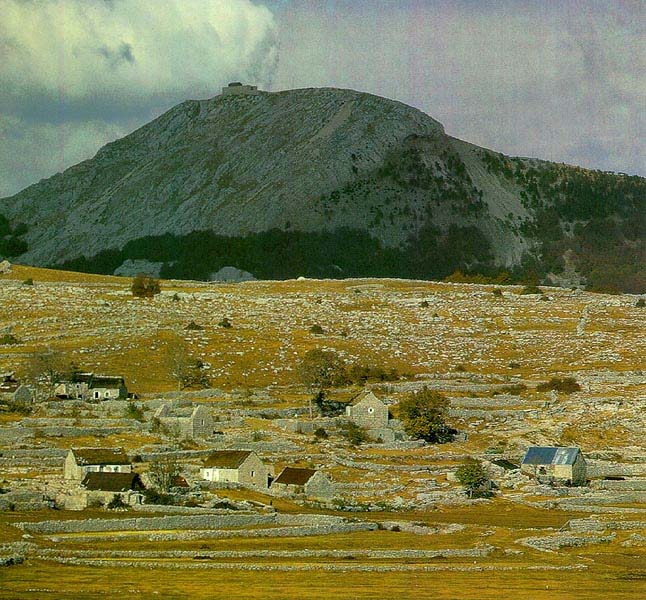
View of Cetinje
|
|
Montenegro, like all places in Dalmazia, uses a musical instrument known by the name Guzia, it is a type of monochord guitar, which is played with a bow to accompany the songs of the people of Montenegro, which tell of heroic events in their history, and some which tell of their loves.
Cettigne, historically the most important city of Montenegro, also from a cultural point of view, as it was the headquarters of the first topography and the first place which opened the country’s first schools. In 1910, when Montenegro became a kingdom, it was in Cettigne that the king Nikola I Petrovich, established his residence, he was father of queen Elena, who later the bride of King Vitorio Emanuele III.
Almost one hundred years before it was Biasoletto who awaken by the cries of the swallows
Woken by the twittering songs of the swallows, nestling in the trees and breaking the silence of nature in that valley, accompanied by the shouts of some shepherd, feeling the need to announce the arrival of a new day during his climb.
A pleasurable and old pastime, which accompanied him in making herbal remedies, as already practised by Rousseau, French writer, walking amongst the fantastic countryside and mountain paths collecting plants and herbs. In fact it was such a beautiful morning as this that looking out from my window that gave me the idea of contemplating the absolute beauty of the valley of Cettigne, how it was brought to life by the rays of the sun, giving it colour, a deep fire red, which completely captured me. This low lying valley, accompanied by giant cress of craggy rocks, for the most part naked , isolated, conical, often acute and inaccessible.
|
|
One breathe this very same atmosphere even today in the higher parts of Cettigne, where on that morning of June 1838, the king was eager to go outside to take a walk, to visit the church ( described in his botanical diary) the rustic architecture, to abandon himself to pleasure of his herbal remedies, before leaving for Budva, where the boat for his return was awaiting him.
Shorter and more mythical , paths were made available, between pendulous hills and distended lawns, interrupted by rests at the springs, but mainly to allow the collection of flowers and tubers (buttercups, clover, asphodels) until he reached , from village to village, the view of Budua (Budva), Immediately afterwards we lost ourselves in an amazing horizon … which on descending became always more pleasant, the sea, the welcoming coast of Budua, always more evident, villages which we met along the roadside, a certain number of regularly and well built houses.
|

Saxifraga Friderici Augusti
|
|
The city of Budva is an attractive centre with a mild climate and pleasurable walks, today it has been brought alive by the presence of many young people, meeting on the beaches and inside the old walls, all have been well restored, with a port full of interesting and picturesque restaurants.
The small city of Budua (Butua,and Butova), is situated on a peninsular and is surrounded by a wall, which is falling into ruin. It has a castle situated high in the north which dominates the city and its port, is partly ruined, and you cannot say that its port is an anchorage, but is secured by small bastions, protected from the southern winds by the nearby island of San Nicola, a distance of about 200 klafter. The city has 182 houses and 170 families, in part catholic and in part Greek, a sea port and another landing port.
|
|
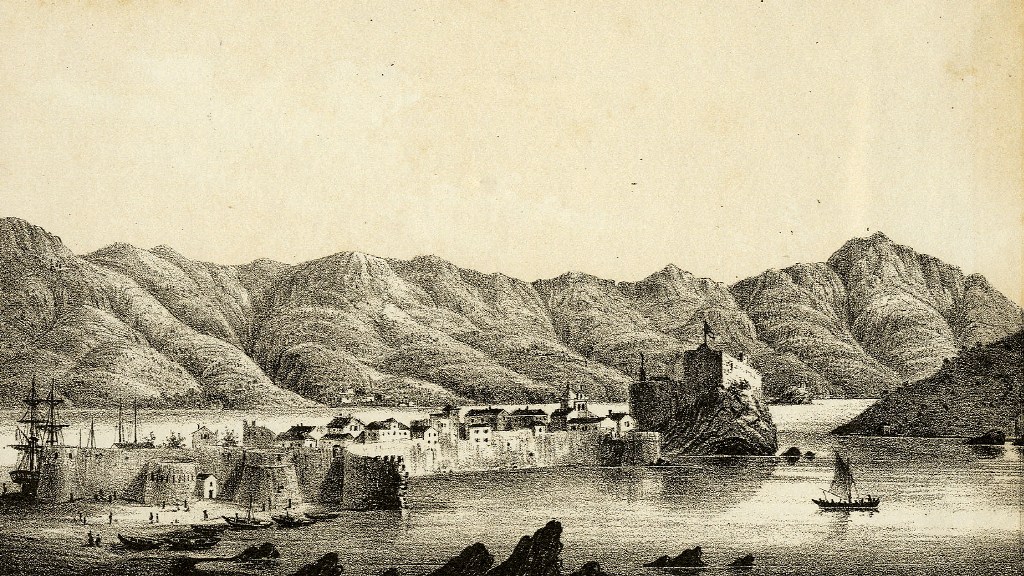
Budva
|
|
Budva is thought to be one of the oldest cities’ of the Mediterranean. As told by old Phoenician legends, and repeated again more than 2,500 years later. Beautiful beaches, 270 days of sunshine and a large number of cultural events, are surely reasons enough to encourage any one to visit this Adriatic locality.
|
|
To the east of the city one can find the small island of Sveti Stefan, city-hotel, first mentioned in 1442. According to the legend it was built thanks to constant spoils of war against the Turkish navy which was anchored in the Mediterranean. It is noted for its beauty found in the old city and for the beaches of Milocer and Becici, prized and classified by United Nations experts.
While our passengers'steamship, visited the city, draws away from the territory of Montenegro towards Ragusa (Dubrovnik), a lovely Venetian city we recommend to visit to those who travel on their footsteps,we will report the observations made by Biasoletto on the people of Montenegro:
|
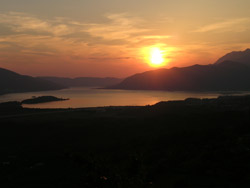
Bay of Budva
|
|
The people of Montenegro are originally of Slav origin, courageous and robust, coming from a strong system, out of need and necessity, education, armed with independence, a little rude, provoked by their political situation, as is the condition of their country, somewhat agricultural, artisans and craftsmen. Immovable in their promises, their friendships, frank and disinterested in their hospitality.
The Botanist concludes with nostalgia in his fascinating diary, charmed by the experience and hoping that the memory will become a legend.
With great pleasure as I turn my eyes back to see from a distance the austerity of those places visited in Montenegro, marvellous places, with much tenacity, almost doubting the truth or not, with our presence.
So his journey, like with all real experiences written down, can be relived and rewritten a thousand times again.
|
|
|
|